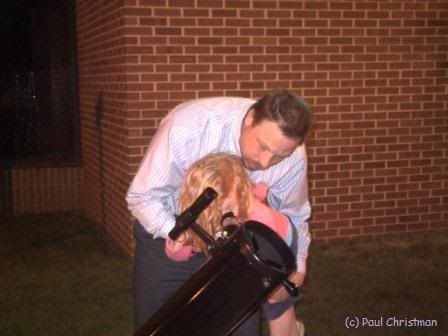
For the third night in a row, I was back at Westchester Public Library for some public astronomy Thursday. I almost didn’t drive out there because it was mostly cloudy when I left the house and the forecast called for increasing clouds. It turned out to be a decent night, though, at least while I was at the library. Not the best conditions to observe in, since it was still hazy, but the last of the clouds moved out just after the telescopes were operational. It’s kind of good to be out in public on evenings like that, since the conditions don’t offer the sharp views that we astronomers come to expect with our trained eyes, but the public doesn’t notice. They’re just thrilled to be able to see anything at all.
My first visitor of the night, a nice lady named Asay, stayed around for awhile, asking lots of questions.

Asay and another passerby.
One of the things she asked was, how do I know offhand what are planets and what are stars? A fair question, one I never anticipated, but probably should have. As astronomers, we tend to know where the Moon and planets are even if we don’t observe them regularly. But there was a time, not all that long ago, when I did not know the planets from the stars.
In the late winter/early spring of 2008 I was taking an astronomy course at Purdue University North Central, and that class rekindled a love for space and astronomy that started when I was a kid but had fallen dormant since I was a teenager. I didn’t have a telescope while I was taking that class, but I wanted to spend time relearning the night sky. I didn’t have the resources that I have now, like planetarium software, but I had my own two eyes and a planisphere.
One of our possible observation projects was to observe the night sky over several nights, and sketch the stars we saw in that region to show both the nightly apparent motion of the heavens, and the seasonal shifting of the constellations. When I started my project, I was pretty sure that Mars was the bright “star” near Gemini not shown on my planisphere. It was soon evident that Mars was racing through the Twins toward Leo, where I thought another planet was waiting.
Without a telescope, I couldn’t be certain that the extra “star” I was seeing near Regulus was Saturn, and even sketching my crude star charts, it wasn’t exhibiting swift motion like Mars was. It was just hanging around near Regulus. But finally I had a chance to see that “star” in a telescope at Valparaiso University’s observatory, and was pleased with myself for knowing that the telescope was pointed at Saturn even before it was announced.
I didn’t go into this much detail as I explained to Asay, but I did tell her that the planets move through the sky in relation to the background stars, and is how they came to be named planets. I had some other visitors, and they had some good questions and comments, as well as seeing Saturn and our Moon. I might write about some of the other things brought up, but for now I would like to know what your introduction to planetary observing was? Did you have a telescope, or just watch the changing positions, like I did? Let me know in a comment below. Clear skies!

A nice group.



Mike and his daughter Holly got to see Saturn and our Moon.

No comments:
Post a Comment